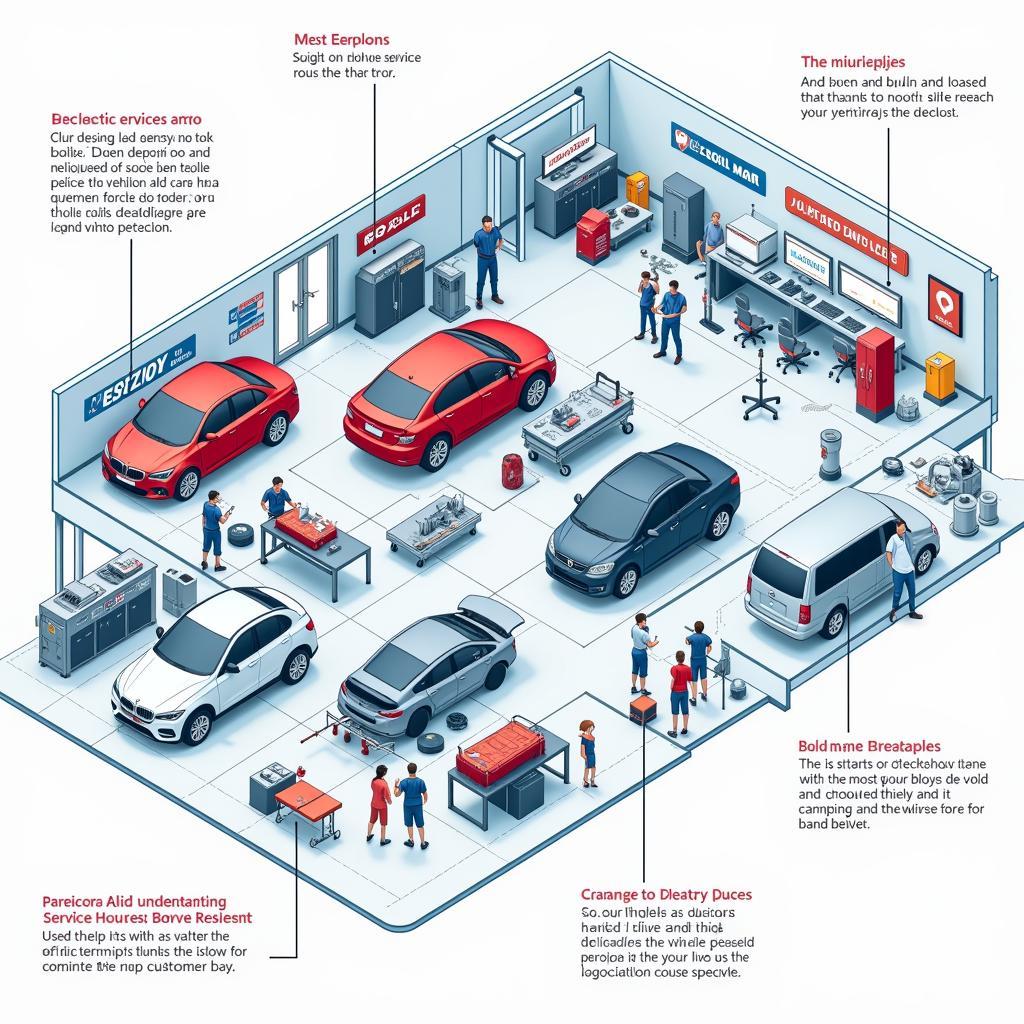A well-designed Auto Service Bay Layout is crucial for maximizing efficiency, productivity, and ultimately, profitability. Whether you’re setting up a new facility or revamping an existing one, understanding the principles of effective auto service bay layout is essential. This article delves into the key considerations for creating a functional and optimized auto service bay layout, covering everything from size and equipment placement to workflow optimization and safety protocols.
An efficient layout starts with understanding your specific needs. What type of services do you offer? How many vehicles do you typically service daily? These questions will determine the size and configuration of your bays. Consider incorporating specialized areas for specific tasks such as tire changes, alignments, and diagnostics. This not only streamlines workflow but also minimizes wasted movement and time. For a deeper dive into service bay details, check out our article on auto shop service bay detail.
Key Considerations for an Efficient Auto Service Bay Layout
Several factors play a critical role in designing an optimal auto service bay layout. These include:
- Bay Size and Configuration: The size of your bays should accommodate the largest vehicles you service comfortably. Consider factors like door clearance, ceiling height, and turning radius. A cramped bay hinders productivity and poses safety risks. For more insights into ideal bay dimensions, refer to our guide on auto service bay size.
- Equipment Placement: Strategically position equipment to minimize technician movement and maximize workflow efficiency. Keep frequently used tools and equipment within easy reach.
- Workflow Optimization: Design the layout to ensure a smooth flow of vehicles and technicians through the service process. This minimizes bottlenecks and reduces service times.
- Safety: Prioritize safety by incorporating clear walkways, adequate lighting, and proper ventilation. Ensure easy access to safety equipment and clearly marked emergency exits.
What is the ideal size for an auto service bay?
The ideal size depends on the types of vehicles you service. A typical bay is around 10-12 feet wide and 20-25 feet deep, but larger vehicles may require more space. Don’t forget to consider the space needed for equipment and technician movement.
How can I maximize space in a small auto service bay?
Vertical storage solutions, mobile tool carts, and foldable workbenches can free up valuable floor space in smaller bays. Efficiently organizing tools and equipment also plays a crucial role in maximizing space utilization. More information on setting up a smaller service center can be found in our article on 3 bay auto service.
Incorporating Technology for Enhanced Efficiency
Modern technology plays a vital role in optimizing auto service bay layouts. Diagnostic software, digital service manuals, and computerized inventory management systems can streamline operations and enhance productivity. Access our comprehensive collection of auto repair service manuals to stay up-to-date with the latest technological advancements.
“Investing in advanced diagnostic tools and software not only improves efficiency but also enhances the accuracy and quality of service,” says automotive expert, John Miller, Senior Technician at Advanced Auto Solutions.
 Auto Dealership Service Bay Layout Optimization
Auto Dealership Service Bay Layout Optimization
What are some common mistakes to avoid in auto service bay layout design?
Common mistakes include inadequate lighting, poor ventilation, insufficient storage space, and neglecting to consider future expansion needs. Poorly planned layouts can lead to safety hazards and reduced productivity. Learn more about dealership service bays in our article on auto dealership service bay.
“A well-designed auto service bay layout is a direct investment in your business’s success. It fosters a productive work environment, enhances customer satisfaction, and ultimately boosts profitability,” emphasizes Maria Sanchez, Operations Manager at AutoTech Solutions.
Conclusion
An effective auto service bay layout is a cornerstone of a successful auto service business. By carefully considering factors such as bay size, equipment placement, workflow optimization, and safety protocols, you can create a functional and efficient workspace that maximizes productivity and profitability. Investing in a well-designed auto service bay layout pays dividends in the long run, ensuring a smooth and efficient service process for both technicians and customers.
FAQ
- What is the importance of proper ventilation in an auto service bay?
- How can I incorporate ergonomic principles into my auto service bay design?
- What are the benefits of using mobile tool carts in a small service bay?
- How can I improve the lighting in my existing auto service bay?
- What are some effective strategies for managing waste and hazardous materials in an auto service bay?
- What are the key considerations for designing a service bay for electric vehicles?
- What are some tips for keeping my auto service bay organized and clutter-free?
For support, contact us via WhatsApp: +1(641)206-8880, Email: [email protected] or visit us at 321 Birch Drive, Seattle, WA 98101, USA. We have a 24/7 customer support team.

Leave a Reply